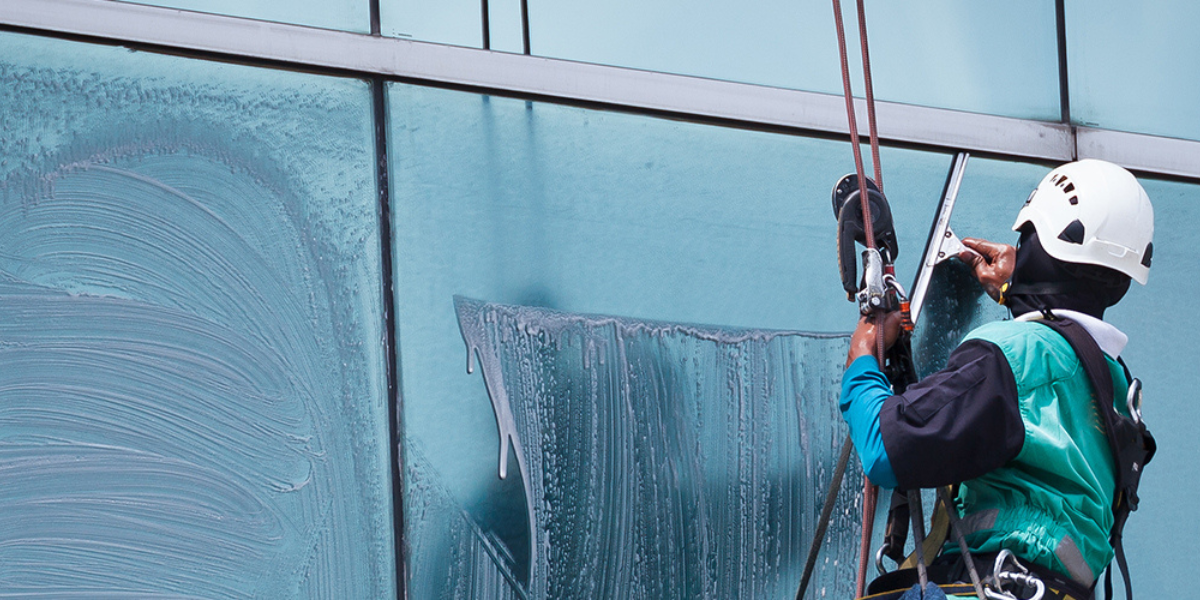- North York, ON
- Info@allseasonenterprise.com
- 416.829.0060
- North York, ON
- Info@allseasonenterprise.com
- 416.829.0060

Tips & Tricks for Cleaning Hardened Cement from Window Glass
Although your remodel was successful, you didn’t notice the cement splatter that had accumulated on the windows during cleaning up yesterday. It was a long day and you didn’t see the cement splatter on the windows because of the dimming light. There are many companies that provide Window washing services in Toronto. However, all season enterprise provides the best commercial window cleaning Toronto services.
Even professionals can find it difficult to remove concrete from glass. It’s difficult to get rid of cement that has been set on glass after it cures. Don’t worry, this post will show you how to get cement splatter off glass and windows using our tried-and-true formula.
What You Need for the Job:
These products can be purchased at your local hardware store.
- The garden hose
- Soft sponges
- 1-gallon bucket
- Specialized glass cleaner
- Paper towel
- Dishwashing soap
- Spray bottle
- Putty knife
- Concrete removing agent
- Soft-bristled toothbrush
Before You Start
These points are important to know before you start implementing your plan.
Use steel wool or abrasive sponges to clean cement from glass. For removing hardened cement from glass, razor blades are not recommended. These tools can permanently scratch or etch glass’s surface and may require a replacement.
This process should not be used in direct sunlight. The UV rays of the sun heat the cleaning agent too fast, which can cause streaking that is difficult to remove. Scratching may occur if there is a chemical residue left on the glass after cleaning.
How do I remove hardened cement sand? A DIY method that works
Add 2 to 3 drops of dishwashing soap to the spray bottle. To prevent scratches, spray the window and lubricate the surface. Spray the cement with soapy water. It is easier to clean cement because of its porous nature.
After you have soaked the cement for a while, you can use a putty knife and scrape the cement from the glass.
Use your hose to rinse the glass and then sponge off any residue. You can rinse the glass again with the hose if there is any cement left. Follow the manufacturer’s instructions to apply your nonacidic cement remover to the window. Some products can be diluted with water, while others require an aerosol spray to deliver.
Spray the remover in shade. Avoid direct sunlight as it may dry the remover. Allow the remover to sit in the cement for the recommended time. You can moisten the cement with a spray bottle if it starts drying.
To remove cement, use a plastic putty knife. Brush stubborn areas with a soft-bristled brush.
Rinse the window using water. Dry it. For stubborn cement deposits, a second cleaning might be necessary. You can then spray the window cleaner on it and scrub off any traces or stains.
Minerals like calcium and magnesium can cause hard water spots. The water evaporates from a surface when it gets wet but leaves behind mineral deposits. Hard water spots can form from showers, car washes, and sprinklers. These deposits are chemically alkali and require acid to be removed. You can prevent the formation of more mineral deposits by using a few household items.
Method 1
1. Using a Vinegar Solution
Mix half water with half vinegar in a spray bottle –
Depending on the severity of water spots, adjust the vinegar-water ratio to make it more effective.Spray vinegar solution onto the glass –
Be sure to thoroughly coat the solution, making sure to get rid of any stubborn water spots and areas that have accumulated too much. Let the vinegar soak for a few minutes, then reapply to any particularly filthy areas. Use the vinegar solution to soak a towel. Then, spread the towel over the glass. The towel can be laid over the glass to allow the vinegar to soak in.Lightly scrub the glass with the towel –
You can also use a damp towel to scrub the glass. Do not scrub too hard. To remove any mineral buildup, the bumps on the towel can be used as an abrasive.Let the vinegar solution sit –
Fewer stains mean more vinegar is needed to work. Allow the vinegar solution to soak in. If it appears to be drying out, reapply.Use a towel or squeegee to remove the vinegar solution.
Method 2
Other Natural Products
You can use lemon juice in place of vinegar –
Lemon Juice has the same acidic properties that vinegar and is equally effective. Lemon juice made from fresh lemons is more effective than lemon juice that has been bottled. You can roll the lemon on a flat surface and apply pressure to cut it open. This will make it easier to squeeze the lemon. Use a squeezer to extract the juice from a lemon. You can also use the lemon to decorate the glass. Simply cut the lemon in half, and use a lot of pressure to rub the glass. Let the lemon soak in for a while, then clean the glass with water or a traditional cleaner.Use orange or lemon essential oil –
These oils have a lot of cleaning and health benefits. Essential oils containing citrus-based essential oils, such as orange and lemon, may help to remove hard water deposits. The oil acts as a water repellant, which may help prevent future spot buildups. Use a few drops of oil to dilute the water and then use a sponge or towel to apply it to the glass. Let the sponge or towel soak for a while, and then gently scrub with the sponge or towel. Use water or a traditional glass cleaner to remove the glass.Use white toothpaste to treat the area –
Toothpaste is designed to dissolve buildup and works well with hard water spots. You can use less toothpaste if you water it down with some water. Allow the paste to dry in the glass. Use a sponge, a towel, or a brush to gently scrub the skin. Use water to wash the paste from the glass. Use water or a traditional cleaner to clean the glass. Dry it well so the water spots don’t re-form.Combine the vinegar and baking soda to make a paste.
The paste should bubble up when combined. The bubbling can be left to cool down or you can directly apply the paste to the glass. You should not mix vinegar and baking soda inside a sealed container. The gas expansion could cause the lid to fly off. The paste should be applied to the glass. Let it sit for a while. Use a brush, a towel, or a sponge to gently scrub the skin. Use water to wash the paste from the glass. Use water or a traditional cleaner to clean the glass. Dry it well so the water spots don’t re-form.
Use a water repellant on the glass to maintain the shine. Need more cleaning windows or post-construction cleaning? Commercial window cleaning Toronto services can help. With up-to-date equipment and advanced cleaning tools, our window washing services Toronto team can bring your house back to life.
About Us
We look forward to being able to safely clean your home with advanced equipment that will bring your property back to life!
Residential services
Commercial Services
copyright 2024. Website Design by Enterprise Web Cloud



